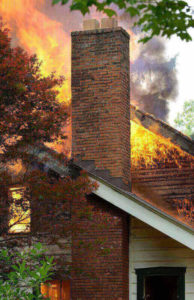If you have a chimney and want to keep your family safe, you need to know the risk and danger of creosote. Most homeowners know little to nothing about creosote, and this is very dangerous. If you have a fireplace, here is what you need to know about creosote.
What is creosote?
 Many homeowners aren’t familiar with creosote. Perhaps you’ve never heard of it. Perhaps you’ve heard about it, but you don’t quite know what it is. Creosote is a byproduct of a wood-burning fire. When wood is burned, gases are released. Those gases, along with particles, travel up your chimney as smoke. As the smoke travels up your chimney, it begins to cool, causing the chemical byproducts from the fire to condensate on the chimney walls. That condensation then hardens into a substance – creosote. Creosote is a hard black or brown substance. It can be smooth and shiny, or it can be a thick, tar-like appearance too, depending on what stage you discover it.
Many homeowners aren’t familiar with creosote. Perhaps you’ve never heard of it. Perhaps you’ve heard about it, but you don’t quite know what it is. Creosote is a byproduct of a wood-burning fire. When wood is burned, gases are released. Those gases, along with particles, travel up your chimney as smoke. As the smoke travels up your chimney, it begins to cool, causing the chemical byproducts from the fire to condensate on the chimney walls. That condensation then hardens into a substance – creosote. Creosote is a hard black or brown substance. It can be smooth and shiny, or it can be a thick, tar-like appearance too, depending on what stage you discover it.
Why is creosote dangerous?
A thin layer of creosote in the chimney of a wood-burning fireplace or heating stove is normal. The problem with creosote is that it builds up over time, and if you have too much inside your system, this is very dangerous. Creosote is highly flammable. When creosote inside your chimney gets too thick; a stray spark, extreme heat or unexpected flareup from the fireplace can cause it to ignite. This then leads to a damaging and potentially dangerous chimney fire.
Thick layers of creosote also can flake away from the walls of the chimney and form a dust on the floor of the chimney. Creosote dust cause health problems if it is allowed to permeate your home to be breathed in or ingested by your family or friends. Creosote in your chimney can cause other problems too. It can stink and give off a disguising odor on hot summer days, and it can restrict the flow of smoke going up your chimney. This causes your fireplace to smoke, and it can cause your fireplace to burn less efficiently too.
What can you do to keep your home and family safe from the dangers of creosote?
To mitigate the dangers of creosote and lower your home’s risk of a chimney fire, the National Fire Protection Association recommends having your chimney swept and inspected by a certified chimney sweep at least once per year. If you burn a lot of wood in your fireplace, you may need to have your chimney swept more frequently. Chimney sweeping removes all creosote that has collected on the walls of your chimney to keep creosote levels at bay.
Now that you know about creosote — and all of its dangers — don’t put your home and family at risk of a chimney fire or creosote exposure. Have your chimney inspected and swept by a professional. Call Environmental Chimney Service to schedule your appointment at 828-243-0098 today!
